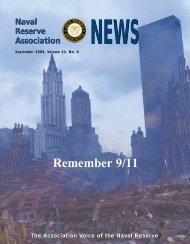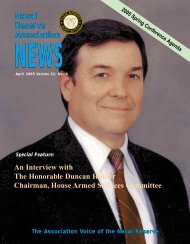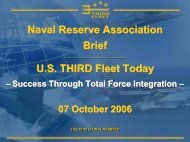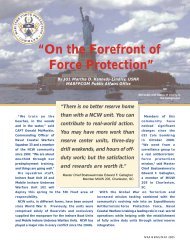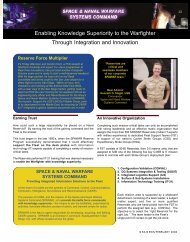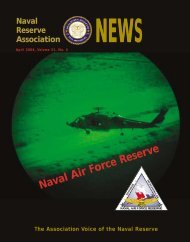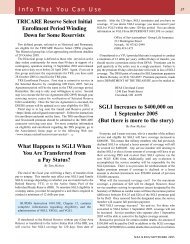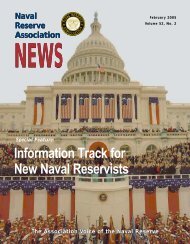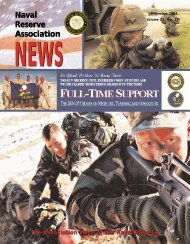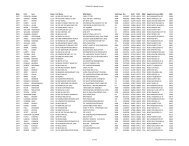Naval Reserve Association Naval Reserve Association
Naval Reserve Association Naval Reserve Association
Naval Reserve Association Naval Reserve Association
Create successful ePaper yourself
Turn your PDF publications into a flip-book with our unique Google optimized e-Paper software.
13<br />
their personnel medical readiness. RAMIS replaced the antiquated<br />
medical <strong>Reserve</strong> Standard Training Administration and Readiness<br />
Support (RSTARS) system and has thrust the Navy <strong>Reserve</strong><br />
Force into a leadership role in medical information management.<br />
As we link more databases to the TRMS viewer tool, it will<br />
provide Navy leadership the visibility and data necessary to make<br />
knowledgeable, timely decisions. DoD is also in the process of<br />
developing a modernized readiness reporting system called the<br />
Defense Readiness Reporting System (DRRS), and they are so<br />
impressed with the total-force viewing capability of TRMS/<br />
NRRM that they have adopted elements of it as a template for<br />
their initial DRRS development.<br />
Lastly, but so important to our alignment and quality of service, is<br />
communication. The timeliness and way in which information<br />
flows is one of every organization’s biggest challenges. And,<br />
the degree to which we effectively communicate significantly<br />
impacts our level of success. We have created several forums/<br />
mechanisms for communicating Navy priorities, key leadership<br />
messages, relevant news, and opportunities to and from the field;<br />
and they have proven to be very effective. We host a weekly<br />
briefing by Video Teleconference (VTC) to inform the force and<br />
solicit input from every echelon; everyone’s invited to dial in,<br />
including active-duty service members. We also established an<br />
e-mail communication protocol through the public affairs office,<br />
to distribute electronically information to more than 5,000 Navy<br />
Reservists and DoD personnel. Our award-winning magazine,<br />
The Navy Reservist, is mailed monthly to every Navy Reservist’s<br />
home (88,000 individuals and their families). One of the primary<br />
concerns we identified, in a focus group, was the lack of information<br />
available to the family members of Reservists who had been<br />
mobilized. So, this year we changed the magazine format to include<br />
a family-focused section in each issue and made it a year-round<br />
resource for both the Reservist and the family member. The<br />
feedback we have had from the field on all these communication<br />
forums has been very positive. The flow of information enables<br />
us to identify issues and opportunities and take action faster than<br />
ever before.<br />
Our goal at CNRFC is to provide the best service and tools<br />
possible to our three customers, the Navy, our Sailors, and our<br />
nation. Our staff has been working diligently up and down the<br />
chain of command, with our active-duty partners and even across<br />
services, to accelerate our alignment and integration efforts and<br />
enable our Sailors to go forward and serve. As we transform our<br />
service into “one Navy,” everyone from our most junior Sailor to<br />
our most senior, stands ready to serve. Our Commander-in-Chief<br />
said, “be ready;” well, the Navy <strong>Reserve</strong> is ready, more potent,<br />
and capable than ever before. The Navy’s <strong>Reserve</strong> force is<br />
comprised of the most skilled and committed professionals<br />
[Citizen Sailors] in the world; and their honor, courage, and<br />
commitment will ensure our success abroad and at home.<br />
CREST Program Trains, Integrates Chaplains and RPs<br />
By JO2 Joe Vermette, NR NPRTRU Clearwater, FL<br />
CAMP LEJEUNE, NC – Chaplain and Religious Program<br />
Specialist Expeditionary Skills Training (CREST) is an<br />
intense seven-week training course that provides<br />
operational readiness and mission capability for Religious<br />
Ministry Team (RMT) personnel each year.<br />
The RMT is comprised of an active or <strong>Reserve</strong> chaplain and an<br />
enlisted religious program specialist (RP). Simply put, this program<br />
prepares RMT personnel as to how to serve better the needs of<br />
their unit, under any condition, in the fleet marine environment.<br />
Chaplains do not bare arms and are specifically classified as<br />
noncombatants. While in the field during combat operations,<br />
chaplains may be exposed to enemy fire. In such events, chaplains<br />
must be protected by a combatant or a person who can bear arms.<br />
That person is a Navy RP.<br />
CREST has been in place since January 1997 and was created<br />
from lessons learned by those who served in the RMTs during<br />
Operation Desert Storm. In that conflict, it was evident the RMT<br />
would greatly benefit from a formal school environment that<br />
would better prepare the team for duty with the Marine Corps.<br />
“RPs could spend more than half of their careers with the<br />
Marines; and it is crucial our students, once they leave CREST,<br />
understand the difference in mentalities,” said Chaplain (CDR)<br />
John Franklin, who serves as director of CREST. “The Marines<br />
have a different mentality summarized by the slogan “steel on<br />
target” that most Navy personnel aren’t used to.”<br />
The role of RP in the battlefield is an important lesson in the<br />
CREST program.<br />
“The RP is in charge on the battlefield, and the chaplain must<br />
listen to his RP,” said RPC (SW/AW/FMF) Jonathan Vogal,<br />
assistant director of CREST. “It’s the RPs job to protect his<br />
chaplain no matter what.”<br />
Navy <strong>Reserve</strong> and active duty train side by side at CREST and<br />
that presents both challenges and benefits.<br />
“In this school, Reservists are usually a little older than their<br />
active-duty counterpart; and there is a very strenuous physical<br />
aspect throughout the program,” Vogal said. “What Reservists<br />
lose in a step, they gain in motivation and drive. They catch up<br />
quickly and do fine through the program and when activated.”<br />
NRA NEWS/AUGUST 2004



